Marketing Report: Analysis of Techniques and Research in Two Companies
VerifiedAdded on 2021/05/30
|26
|5504
|80
Report
AI Summary
This report provides an in-depth analysis of the marketing strategies employed by Heineken and H&M. It begins with background information on both companies, followed by an examination of their branding and relationship marketing approaches, market segmentation strategies, and marketing mix elements. The report also explores business objectives, growth strategies using Ansoff's Matrix, and survival strategies for both organizations. Furthermore, it delves into the limitations and constraints of marketing, emphasizing unfair trading and consumer protection regulations. A significant portion of the report focuses on the application of marketing research, including the SOSTAC framework, information gathering techniques, and the use of PEST, SWOT, and SMART objectives. The report compares marketing techniques, discusses limitations of marketing research, evaluates the effectiveness of these techniques, and offers recommendations for improving the validity of marketing research in developing marketing plans, specifically for H&M. The research methods used in this report include both primary and secondary sources. Finally, the report offers insights on how market research aligns with organizational objectives and concludes with recommendations for improvement.
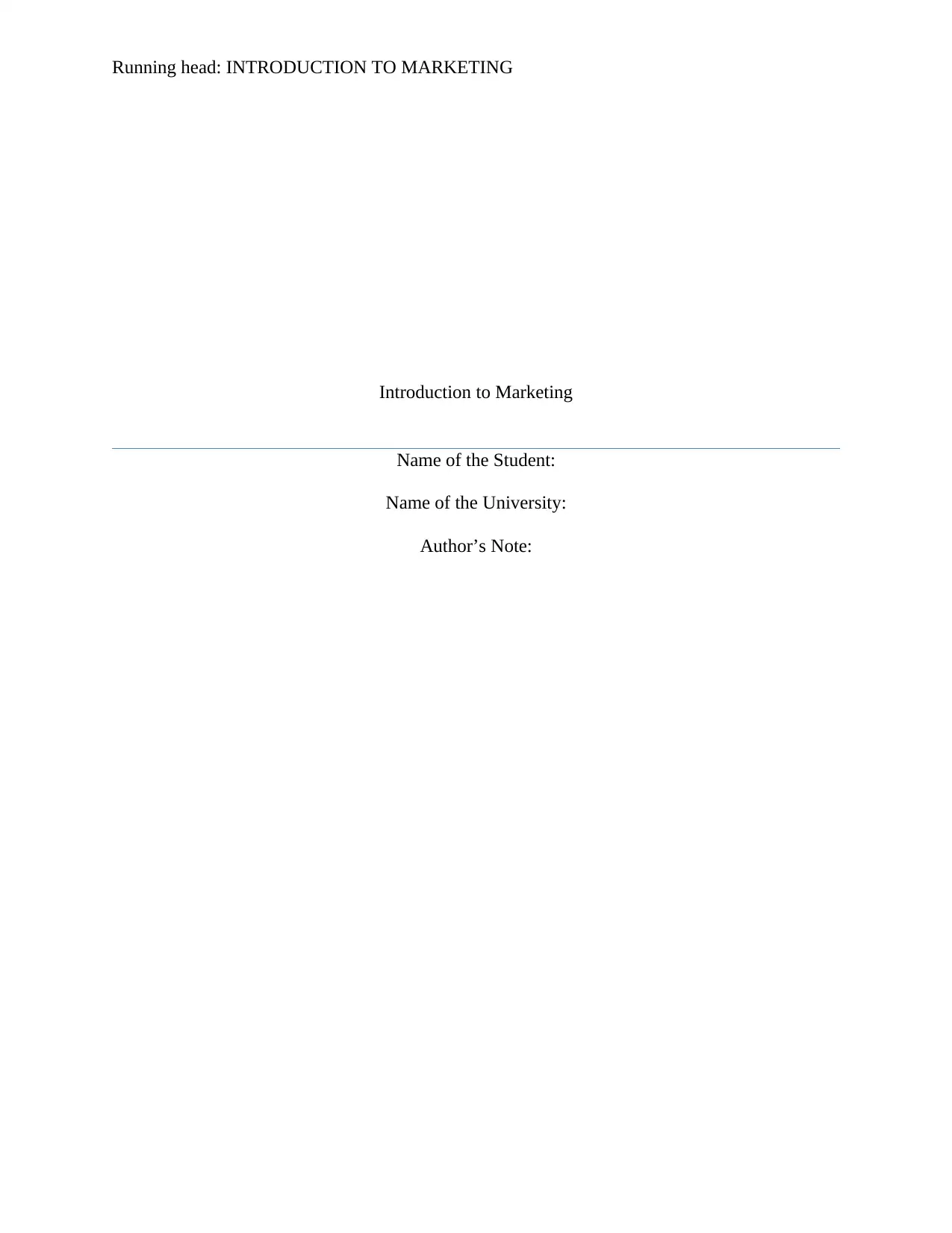
Running head: INTRODUCTION TO MARKETING
Introduction to Marketing
Name of the Student:
Name of the University:
Author’s Note:
Introduction to Marketing
Name of the Student:
Name of the University:
Author’s Note:
Paraphrase This Document
Need a fresh take? Get an instant paraphrase of this document with our AI Paraphraser
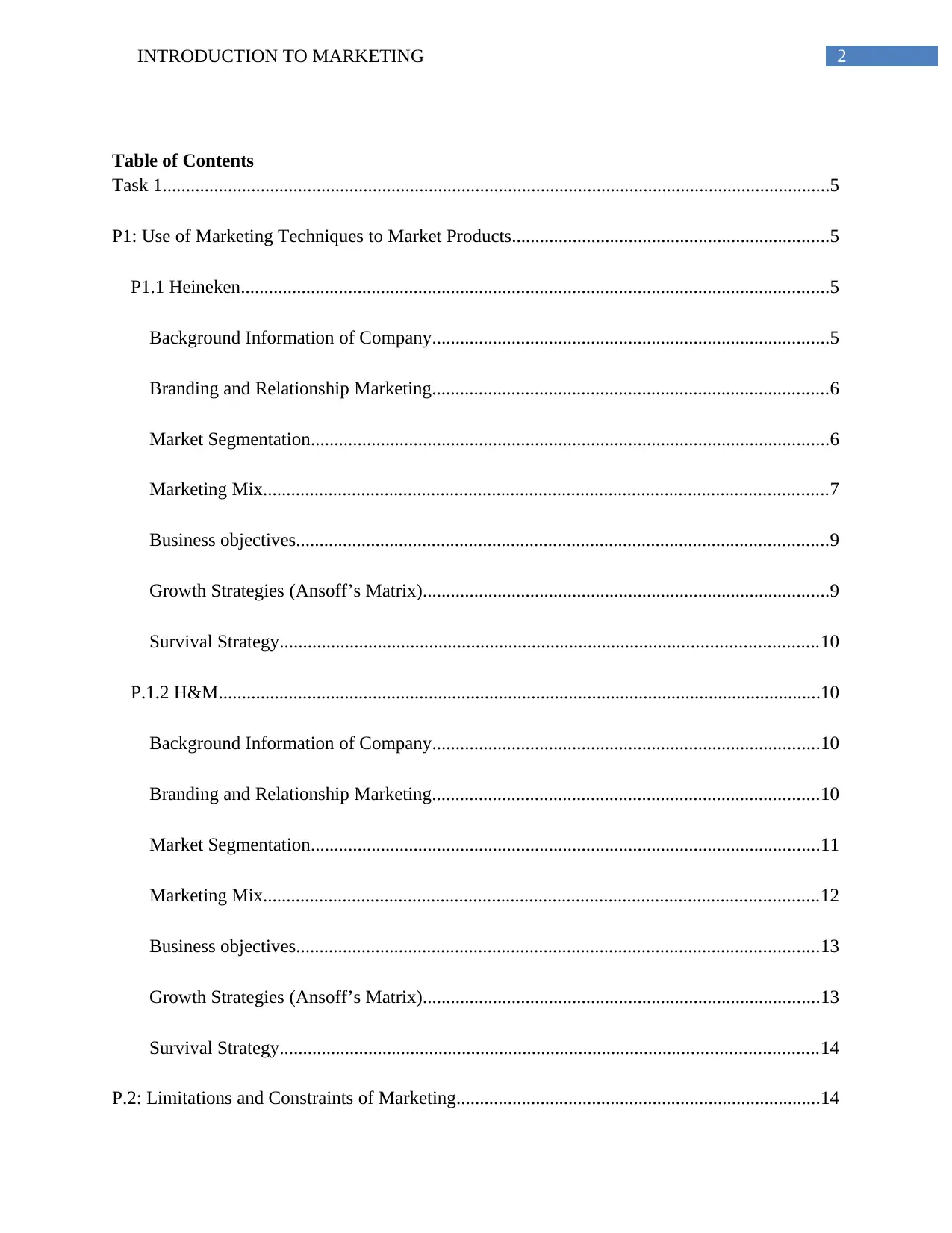
2INTRODUCTION TO MARKETING
Table of Contents
Task 1...............................................................................................................................................5
P1: Use of Marketing Techniques to Market Products....................................................................5
P1.1 Heineken..............................................................................................................................5
Background Information of Company.....................................................................................5
Branding and Relationship Marketing.....................................................................................6
Market Segmentation...............................................................................................................6
Marketing Mix.........................................................................................................................7
Business objectives..................................................................................................................9
Growth Strategies (Ansoff’s Matrix).......................................................................................9
Survival Strategy...................................................................................................................10
P.1.2 H&M.................................................................................................................................10
Background Information of Company...................................................................................10
Branding and Relationship Marketing...................................................................................10
Market Segmentation.............................................................................................................11
Marketing Mix.......................................................................................................................12
Business objectives................................................................................................................13
Growth Strategies (Ansoff’s Matrix).....................................................................................13
Survival Strategy...................................................................................................................14
P.2: Limitations and Constraints of Marketing..............................................................................14
Table of Contents
Task 1...............................................................................................................................................5
P1: Use of Marketing Techniques to Market Products....................................................................5
P1.1 Heineken..............................................................................................................................5
Background Information of Company.....................................................................................5
Branding and Relationship Marketing.....................................................................................6
Market Segmentation...............................................................................................................6
Marketing Mix.........................................................................................................................7
Business objectives..................................................................................................................9
Growth Strategies (Ansoff’s Matrix).......................................................................................9
Survival Strategy...................................................................................................................10
P.1.2 H&M.................................................................................................................................10
Background Information of Company...................................................................................10
Branding and Relationship Marketing...................................................................................10
Market Segmentation.............................................................................................................11
Marketing Mix.......................................................................................................................12
Business objectives................................................................................................................13
Growth Strategies (Ansoff’s Matrix).....................................................................................13
Survival Strategy...................................................................................................................14
P.2: Limitations and Constraints of Marketing..............................................................................14
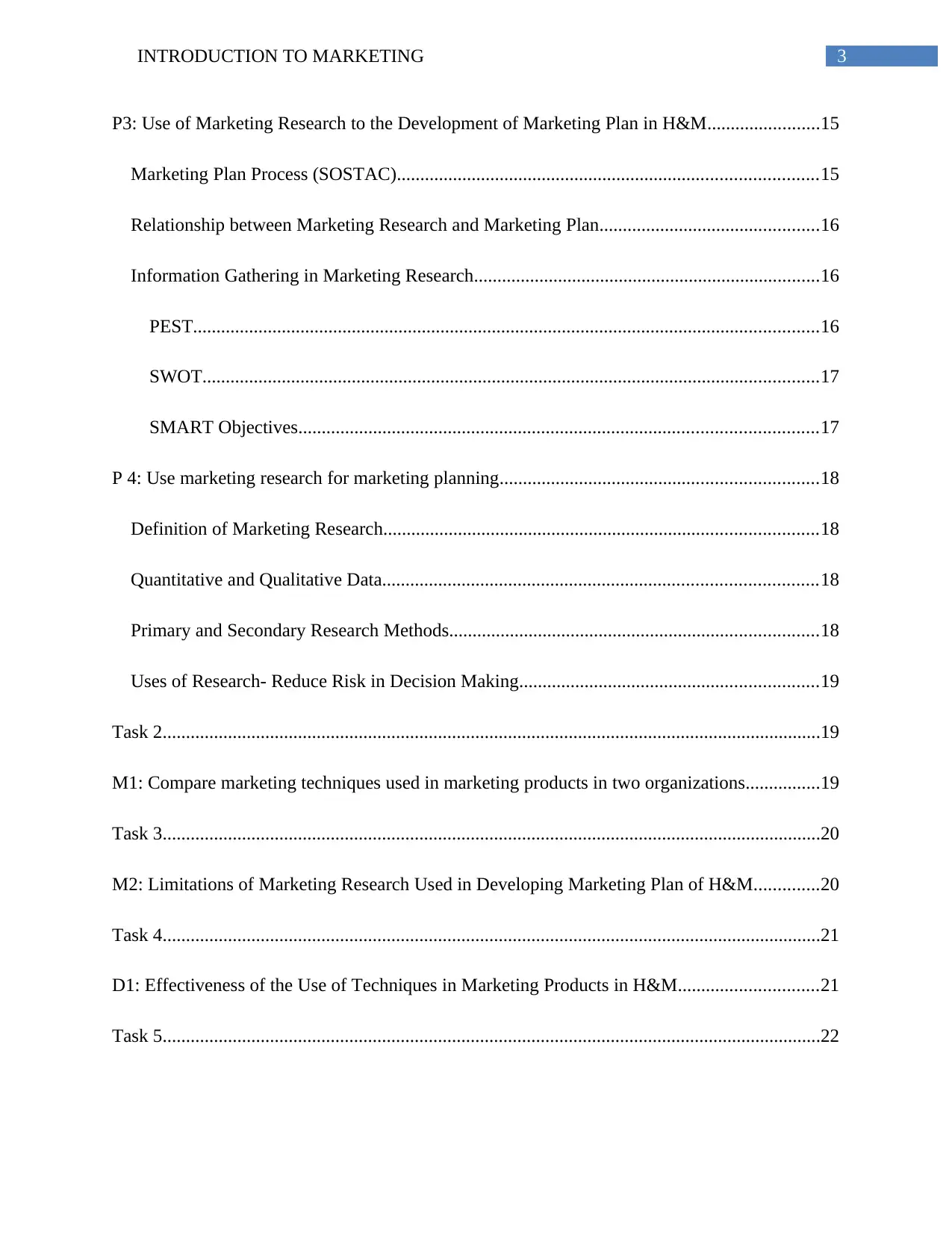
3INTRODUCTION TO MARKETING
P3: Use of Marketing Research to the Development of Marketing Plan in H&M........................15
Marketing Plan Process (SOSTAC)..........................................................................................15
Relationship between Marketing Research and Marketing Plan...............................................16
Information Gathering in Marketing Research..........................................................................16
PEST......................................................................................................................................16
SWOT....................................................................................................................................17
SMART Objectives...............................................................................................................17
P 4: Use marketing research for marketing planning....................................................................18
Definition of Marketing Research.............................................................................................18
Quantitative and Qualitative Data.............................................................................................18
Primary and Secondary Research Methods...............................................................................18
Uses of Research- Reduce Risk in Decision Making................................................................19
Task 2.............................................................................................................................................19
M1: Compare marketing techniques used in marketing products in two organizations................19
Task 3.............................................................................................................................................20
M2: Limitations of Marketing Research Used in Developing Marketing Plan of H&M..............20
Task 4.............................................................................................................................................21
D1: Effectiveness of the Use of Techniques in Marketing Products in H&M..............................21
Task 5.............................................................................................................................................22
P3: Use of Marketing Research to the Development of Marketing Plan in H&M........................15
Marketing Plan Process (SOSTAC)..........................................................................................15
Relationship between Marketing Research and Marketing Plan...............................................16
Information Gathering in Marketing Research..........................................................................16
PEST......................................................................................................................................16
SWOT....................................................................................................................................17
SMART Objectives...............................................................................................................17
P 4: Use marketing research for marketing planning....................................................................18
Definition of Marketing Research.............................................................................................18
Quantitative and Qualitative Data.............................................................................................18
Primary and Secondary Research Methods...............................................................................18
Uses of Research- Reduce Risk in Decision Making................................................................19
Task 2.............................................................................................................................................19
M1: Compare marketing techniques used in marketing products in two organizations................19
Task 3.............................................................................................................................................20
M2: Limitations of Marketing Research Used in Developing Marketing Plan of H&M..............20
Task 4.............................................................................................................................................21
D1: Effectiveness of the Use of Techniques in Marketing Products in H&M..............................21
Task 5.............................................................................................................................................22
⊘ This is a preview!⊘
Do you want full access?
Subscribe today to unlock all pages.

Trusted by 1+ million students worldwide
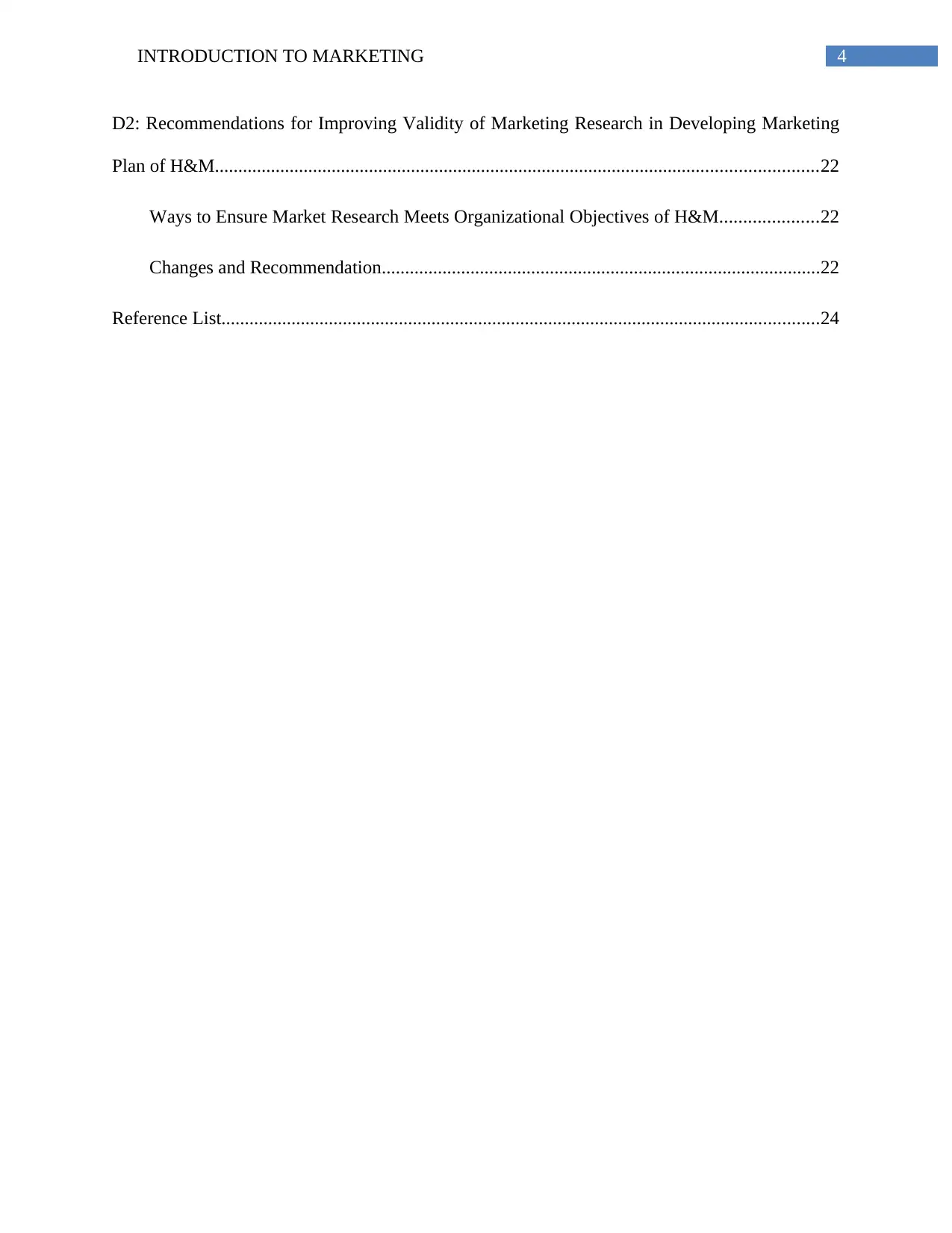
4INTRODUCTION TO MARKETING
D2: Recommendations for Improving Validity of Marketing Research in Developing Marketing
Plan of H&M.................................................................................................................................22
Ways to Ensure Market Research Meets Organizational Objectives of H&M.....................22
Changes and Recommendation..............................................................................................22
Reference List................................................................................................................................24
D2: Recommendations for Improving Validity of Marketing Research in Developing Marketing
Plan of H&M.................................................................................................................................22
Ways to Ensure Market Research Meets Organizational Objectives of H&M.....................22
Changes and Recommendation..............................................................................................22
Reference List................................................................................................................................24
Paraphrase This Document
Need a fresh take? Get an instant paraphrase of this document with our AI Paraphraser
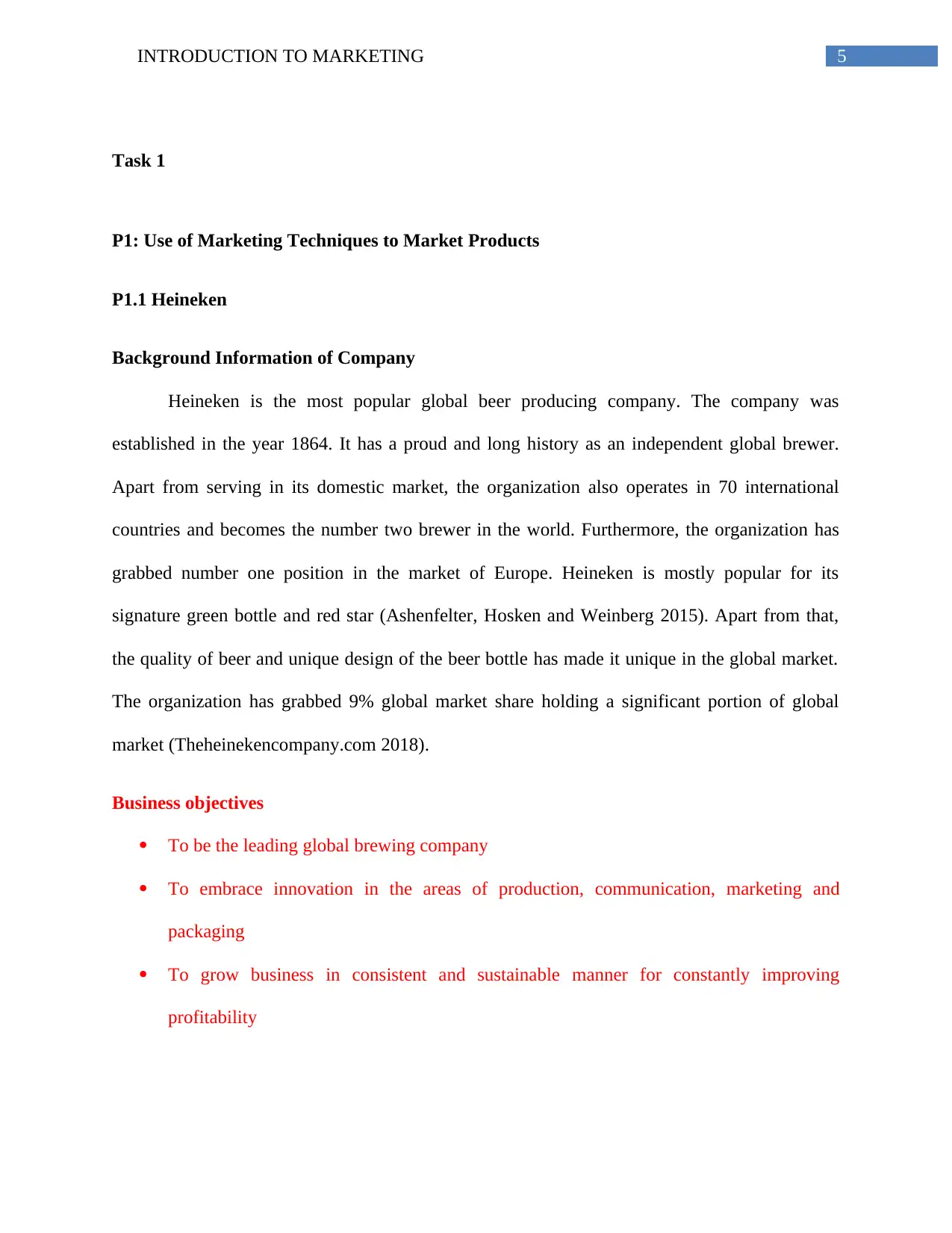
5INTRODUCTION TO MARKETING
Task 1
P1: Use of Marketing Techniques to Market Products
P1.1 Heineken
Background Information of Company
Heineken is the most popular global beer producing company. The company was
established in the year 1864. It has a proud and long history as an independent global brewer.
Apart from serving in its domestic market, the organization also operates in 70 international
countries and becomes the number two brewer in the world. Furthermore, the organization has
grabbed number one position in the market of Europe. Heineken is mostly popular for its
signature green bottle and red star (Ashenfelter, Hosken and Weinberg 2015). Apart from that,
the quality of beer and unique design of the beer bottle has made it unique in the global market.
The organization has grabbed 9% global market share holding a significant portion of global
market (Theheinekencompany.com 2018).
Business objectives
To be the leading global brewing company
To embrace innovation in the areas of production, communication, marketing and
packaging
To grow business in consistent and sustainable manner for constantly improving
profitability
Task 1
P1: Use of Marketing Techniques to Market Products
P1.1 Heineken
Background Information of Company
Heineken is the most popular global beer producing company. The company was
established in the year 1864. It has a proud and long history as an independent global brewer.
Apart from serving in its domestic market, the organization also operates in 70 international
countries and becomes the number two brewer in the world. Furthermore, the organization has
grabbed number one position in the market of Europe. Heineken is mostly popular for its
signature green bottle and red star (Ashenfelter, Hosken and Weinberg 2015). Apart from that,
the quality of beer and unique design of the beer bottle has made it unique in the global market.
The organization has grabbed 9% global market share holding a significant portion of global
market (Theheinekencompany.com 2018).
Business objectives
To be the leading global brewing company
To embrace innovation in the areas of production, communication, marketing and
packaging
To grow business in consistent and sustainable manner for constantly improving
profitability
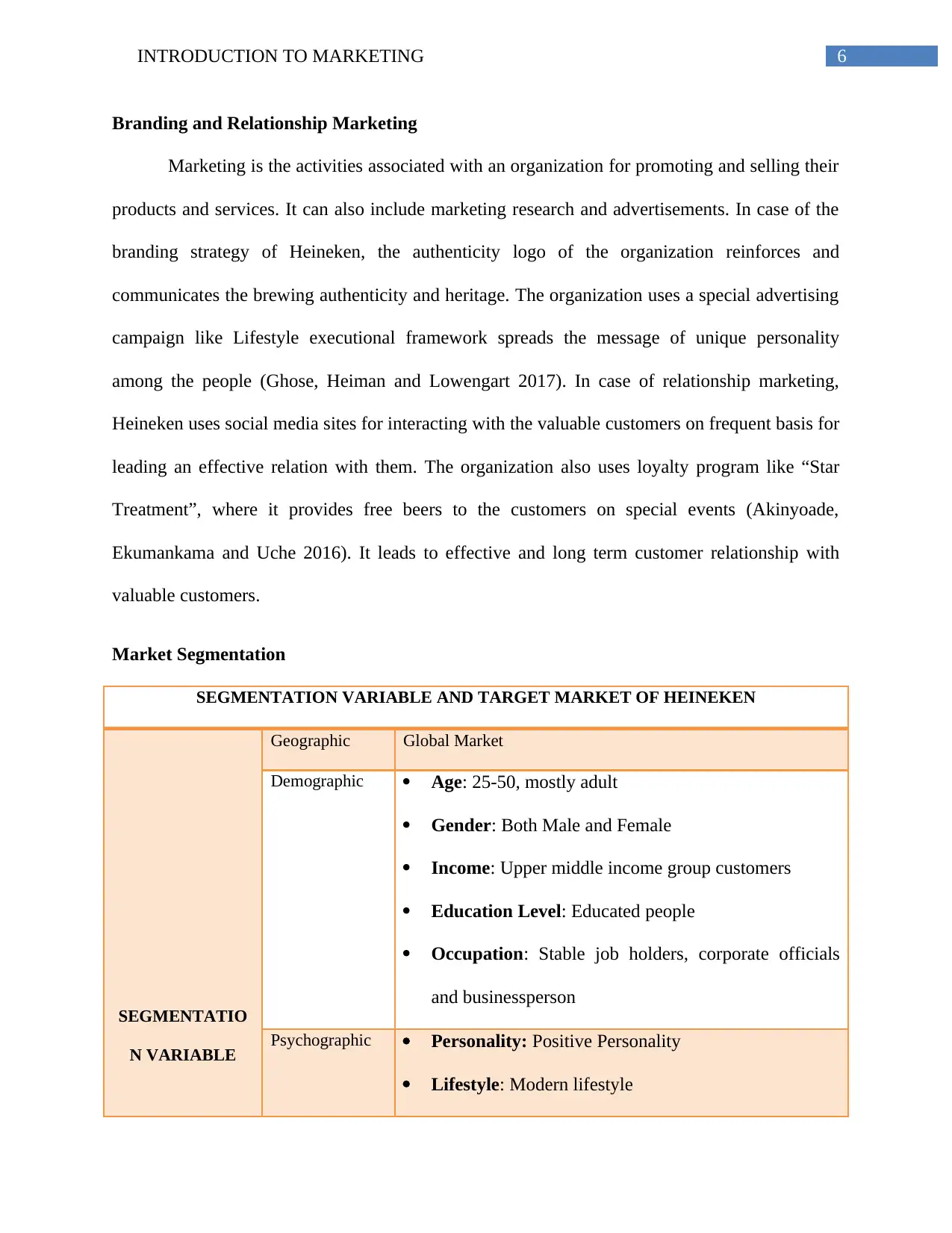
6INTRODUCTION TO MARKETING
Branding and Relationship Marketing
Marketing is the activities associated with an organization for promoting and selling their
products and services. It can also include marketing research and advertisements. In case of the
branding strategy of Heineken, the authenticity logo of the organization reinforces and
communicates the brewing authenticity and heritage. The organization uses a special advertising
campaign like Lifestyle executional framework spreads the message of unique personality
among the people (Ghose, Heiman and Lowengart 2017). In case of relationship marketing,
Heineken uses social media sites for interacting with the valuable customers on frequent basis for
leading an effective relation with them. The organization also uses loyalty program like “Star
Treatment”, where it provides free beers to the customers on special events (Akinyoade,
Ekumankama and Uche 2016). It leads to effective and long term customer relationship with
valuable customers.
Market Segmentation
SEGMENTATION VARIABLE AND TARGET MARKET OF HEINEKEN
SEGMENTATIO
N VARIABLE
Geographic Global Market
Demographic Age: 25-50, mostly adult
Gender: Both Male and Female
Income: Upper middle income group customers
Education Level: Educated people
Occupation: Stable job holders, corporate officials
and businessperson
Psychographic Personality: Positive Personality
Lifestyle: Modern lifestyle
Branding and Relationship Marketing
Marketing is the activities associated with an organization for promoting and selling their
products and services. It can also include marketing research and advertisements. In case of the
branding strategy of Heineken, the authenticity logo of the organization reinforces and
communicates the brewing authenticity and heritage. The organization uses a special advertising
campaign like Lifestyle executional framework spreads the message of unique personality
among the people (Ghose, Heiman and Lowengart 2017). In case of relationship marketing,
Heineken uses social media sites for interacting with the valuable customers on frequent basis for
leading an effective relation with them. The organization also uses loyalty program like “Star
Treatment”, where it provides free beers to the customers on special events (Akinyoade,
Ekumankama and Uche 2016). It leads to effective and long term customer relationship with
valuable customers.
Market Segmentation
SEGMENTATION VARIABLE AND TARGET MARKET OF HEINEKEN
SEGMENTATIO
N VARIABLE
Geographic Global Market
Demographic Age: 25-50, mostly adult
Gender: Both Male and Female
Income: Upper middle income group customers
Education Level: Educated people
Occupation: Stable job holders, corporate officials
and businessperson
Psychographic Personality: Positive Personality
Lifestyle: Modern lifestyle
⊘ This is a preview!⊘
Do you want full access?
Subscribe today to unlock all pages.

Trusted by 1+ million students worldwide
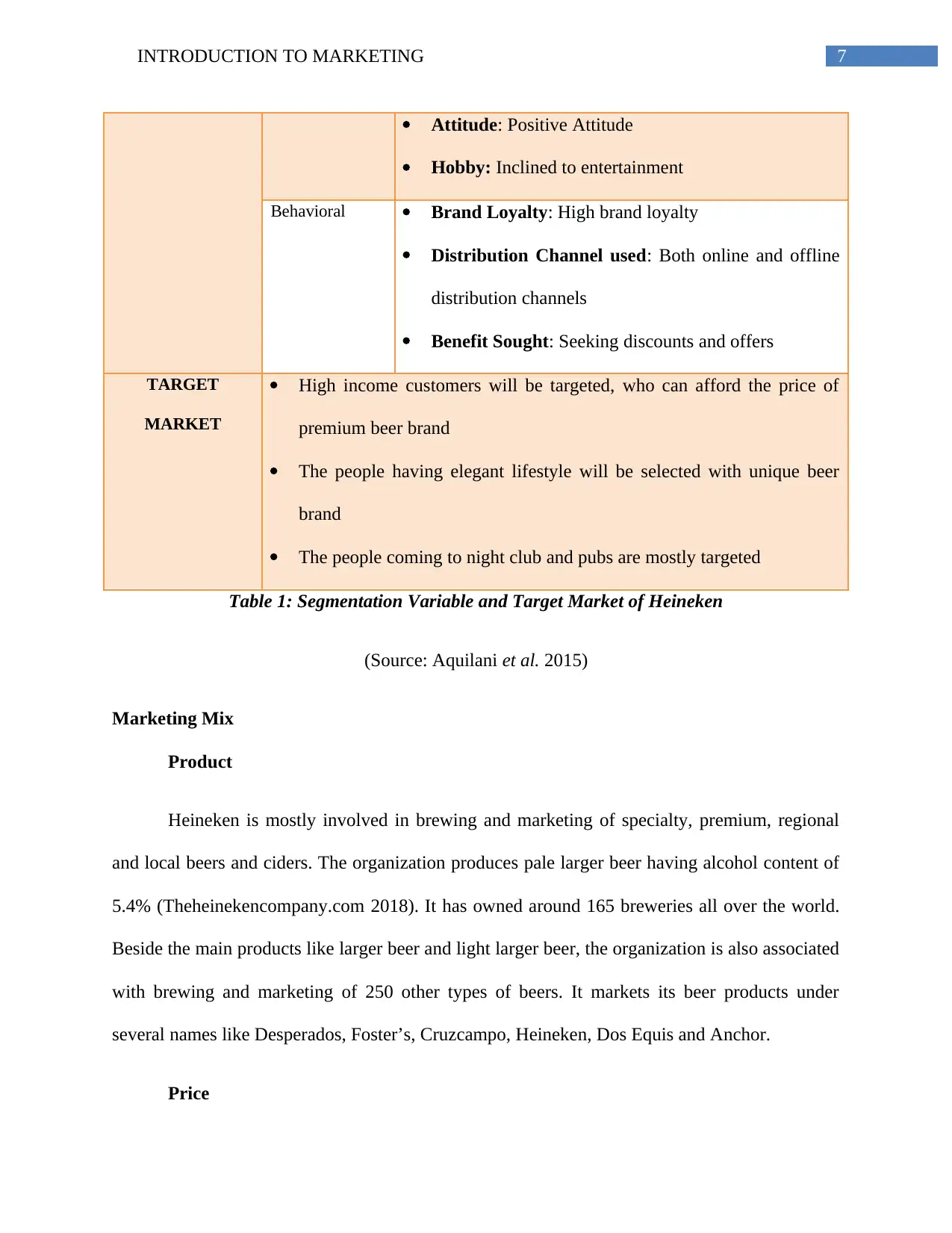
7INTRODUCTION TO MARKETING
Attitude: Positive Attitude
Hobby: Inclined to entertainment
Behavioral Brand Loyalty: High brand loyalty
Distribution Channel used: Both online and offline
distribution channels
Benefit Sought: Seeking discounts and offers
TARGET
MARKET
High income customers will be targeted, who can afford the price of
premium beer brand
The people having elegant lifestyle will be selected with unique beer
brand
The people coming to night club and pubs are mostly targeted
Table 1: Segmentation Variable and Target Market of Heineken
(Source: Aquilani et al. 2015)
Marketing Mix
Product
Heineken is mostly involved in brewing and marketing of specialty, premium, regional
and local beers and ciders. The organization produces pale larger beer having alcohol content of
5.4% (Theheinekencompany.com 2018). It has owned around 165 breweries all over the world.
Beside the main products like larger beer and light larger beer, the organization is also associated
with brewing and marketing of 250 other types of beers. It markets its beer products under
several names like Desperados, Foster’s, Cruzcampo, Heineken, Dos Equis and Anchor.
Price
Attitude: Positive Attitude
Hobby: Inclined to entertainment
Behavioral Brand Loyalty: High brand loyalty
Distribution Channel used: Both online and offline
distribution channels
Benefit Sought: Seeking discounts and offers
TARGET
MARKET
High income customers will be targeted, who can afford the price of
premium beer brand
The people having elegant lifestyle will be selected with unique beer
brand
The people coming to night club and pubs are mostly targeted
Table 1: Segmentation Variable and Target Market of Heineken
(Source: Aquilani et al. 2015)
Marketing Mix
Product
Heineken is mostly involved in brewing and marketing of specialty, premium, regional
and local beers and ciders. The organization produces pale larger beer having alcohol content of
5.4% (Theheinekencompany.com 2018). It has owned around 165 breweries all over the world.
Beside the main products like larger beer and light larger beer, the organization is also associated
with brewing and marketing of 250 other types of beers. It markets its beer products under
several names like Desperados, Foster’s, Cruzcampo, Heineken, Dos Equis and Anchor.
Price
Paraphrase This Document
Need a fresh take? Get an instant paraphrase of this document with our AI Paraphraser
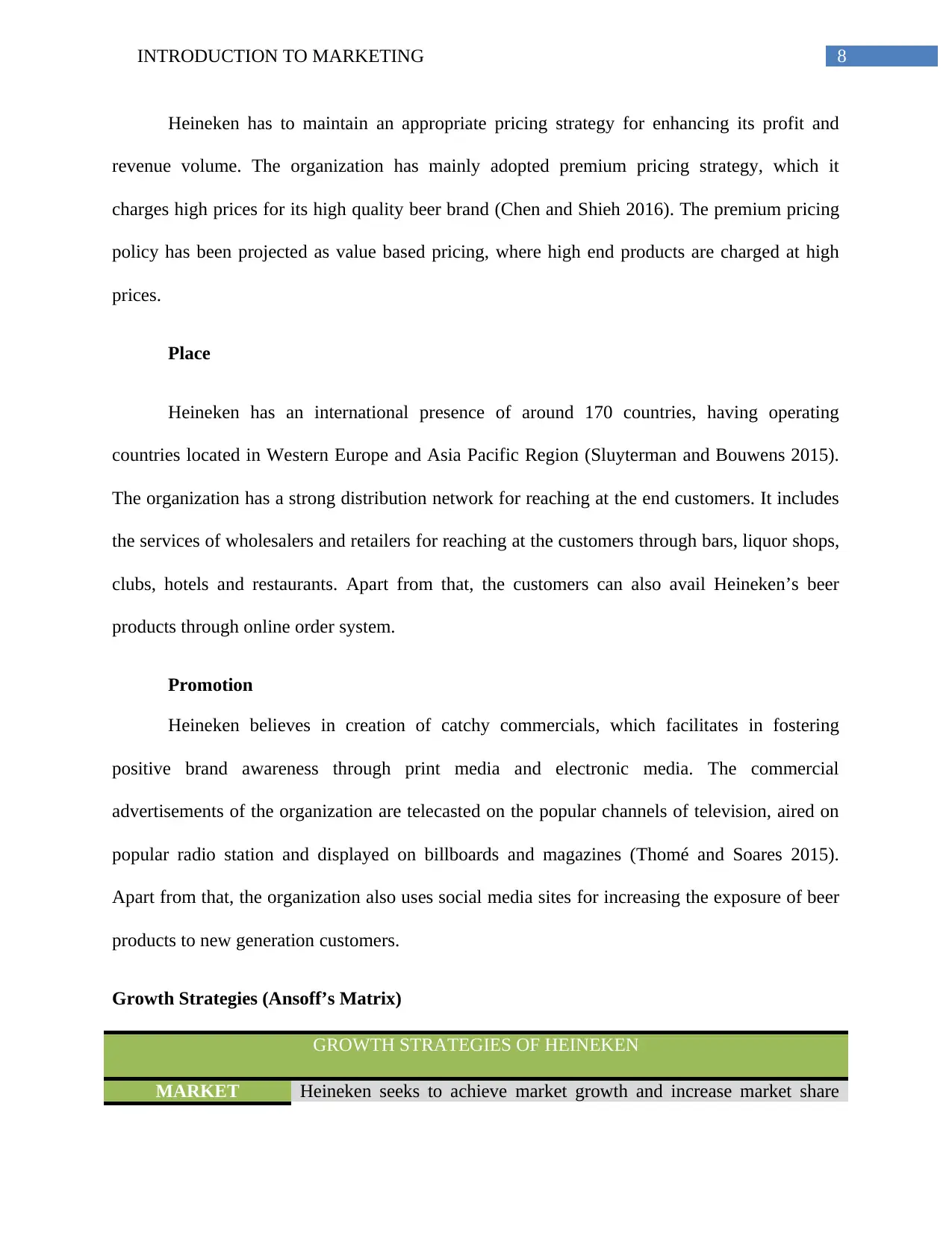
8INTRODUCTION TO MARKETING
Heineken has to maintain an appropriate pricing strategy for enhancing its profit and
revenue volume. The organization has mainly adopted premium pricing strategy, which it
charges high prices for its high quality beer brand (Chen and Shieh 2016). The premium pricing
policy has been projected as value based pricing, where high end products are charged at high
prices.
Place
Heineken has an international presence of around 170 countries, having operating
countries located in Western Europe and Asia Pacific Region (Sluyterman and Bouwens 2015).
The organization has a strong distribution network for reaching at the end customers. It includes
the services of wholesalers and retailers for reaching at the customers through bars, liquor shops,
clubs, hotels and restaurants. Apart from that, the customers can also avail Heineken’s beer
products through online order system.
Promotion
Heineken believes in creation of catchy commercials, which facilitates in fostering
positive brand awareness through print media and electronic media. The commercial
advertisements of the organization are telecasted on the popular channels of television, aired on
popular radio station and displayed on billboards and magazines (Thomé and Soares 2015).
Apart from that, the organization also uses social media sites for increasing the exposure of beer
products to new generation customers.
Growth Strategies (Ansoff’s Matrix)
GROWTH STRATEGIES OF HEINEKEN
MARKET Heineken seeks to achieve market growth and increase market share
Heineken has to maintain an appropriate pricing strategy for enhancing its profit and
revenue volume. The organization has mainly adopted premium pricing strategy, which it
charges high prices for its high quality beer brand (Chen and Shieh 2016). The premium pricing
policy has been projected as value based pricing, where high end products are charged at high
prices.
Place
Heineken has an international presence of around 170 countries, having operating
countries located in Western Europe and Asia Pacific Region (Sluyterman and Bouwens 2015).
The organization has a strong distribution network for reaching at the end customers. It includes
the services of wholesalers and retailers for reaching at the customers through bars, liquor shops,
clubs, hotels and restaurants. Apart from that, the customers can also avail Heineken’s beer
products through online order system.
Promotion
Heineken believes in creation of catchy commercials, which facilitates in fostering
positive brand awareness through print media and electronic media. The commercial
advertisements of the organization are telecasted on the popular channels of television, aired on
popular radio station and displayed on billboards and magazines (Thomé and Soares 2015).
Apart from that, the organization also uses social media sites for increasing the exposure of beer
products to new generation customers.
Growth Strategies (Ansoff’s Matrix)
GROWTH STRATEGIES OF HEINEKEN
MARKET Heineken seeks to achieve market growth and increase market share
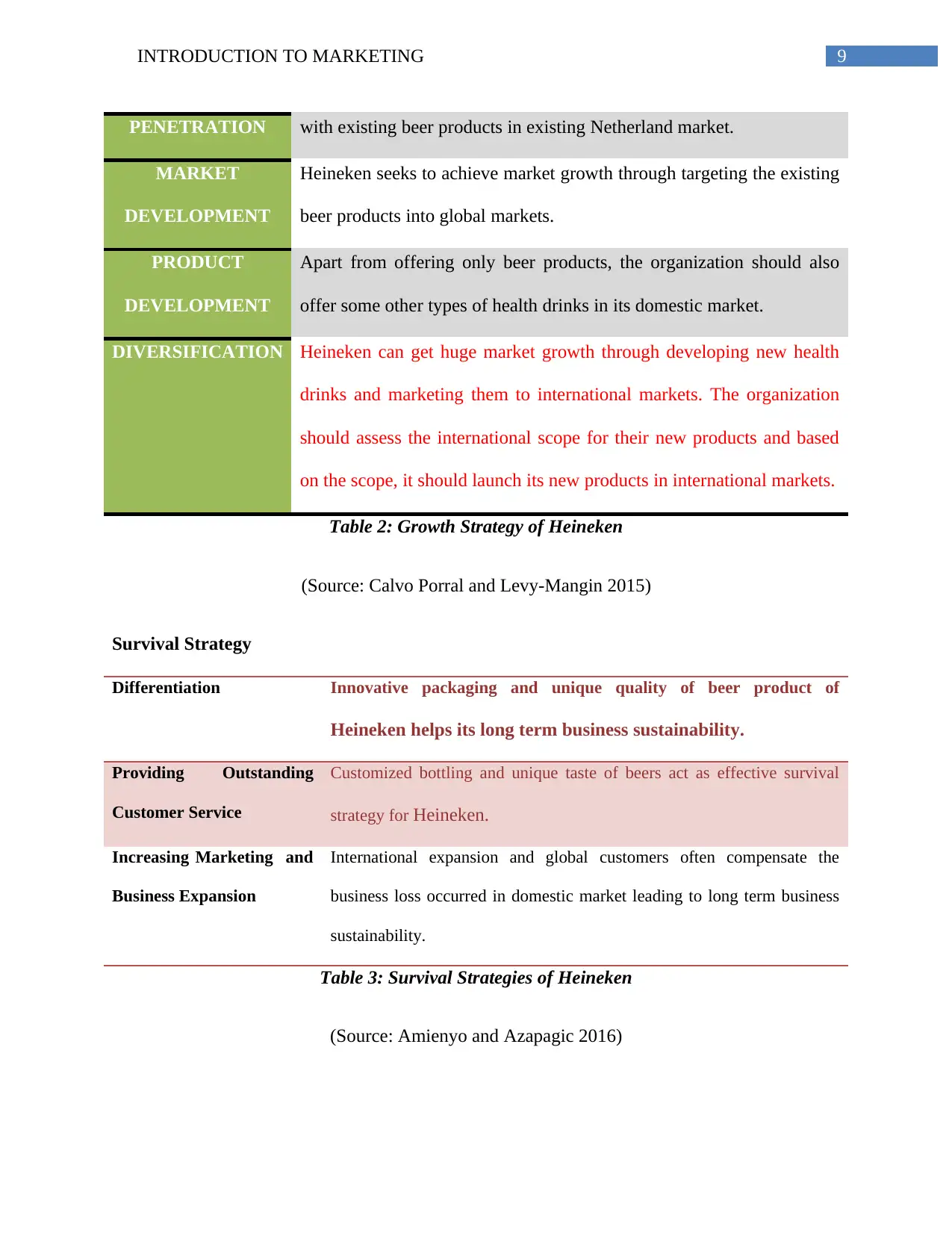
9INTRODUCTION TO MARKETING
PENETRATION with existing beer products in existing Netherland market.
MARKET
DEVELOPMENT
Heineken seeks to achieve market growth through targeting the existing
beer products into global markets.
PRODUCT
DEVELOPMENT
Apart from offering only beer products, the organization should also
offer some other types of health drinks in its domestic market.
DIVERSIFICATION Heineken can get huge market growth through developing new health
drinks and marketing them to international markets. The organization
should assess the international scope for their new products and based
on the scope, it should launch its new products in international markets.
Table 2: Growth Strategy of Heineken
(Source: Calvo Porral and Levy-Mangin 2015)
Survival Strategy
Differentiation Innovative packaging and unique quality of beer product of
Heineken helps its long term business sustainability.
Providing Outstanding
Customer Service
Customized bottling and unique taste of beers act as effective survival
strategy for Heineken.
Increasing Marketing and
Business Expansion
International expansion and global customers often compensate the
business loss occurred in domestic market leading to long term business
sustainability.
Table 3: Survival Strategies of Heineken
(Source: Amienyo and Azapagic 2016)
PENETRATION with existing beer products in existing Netherland market.
MARKET
DEVELOPMENT
Heineken seeks to achieve market growth through targeting the existing
beer products into global markets.
PRODUCT
DEVELOPMENT
Apart from offering only beer products, the organization should also
offer some other types of health drinks in its domestic market.
DIVERSIFICATION Heineken can get huge market growth through developing new health
drinks and marketing them to international markets. The organization
should assess the international scope for their new products and based
on the scope, it should launch its new products in international markets.
Table 2: Growth Strategy of Heineken
(Source: Calvo Porral and Levy-Mangin 2015)
Survival Strategy
Differentiation Innovative packaging and unique quality of beer product of
Heineken helps its long term business sustainability.
Providing Outstanding
Customer Service
Customized bottling and unique taste of beers act as effective survival
strategy for Heineken.
Increasing Marketing and
Business Expansion
International expansion and global customers often compensate the
business loss occurred in domestic market leading to long term business
sustainability.
Table 3: Survival Strategies of Heineken
(Source: Amienyo and Azapagic 2016)
⊘ This is a preview!⊘
Do you want full access?
Subscribe today to unlock all pages.

Trusted by 1+ million students worldwide
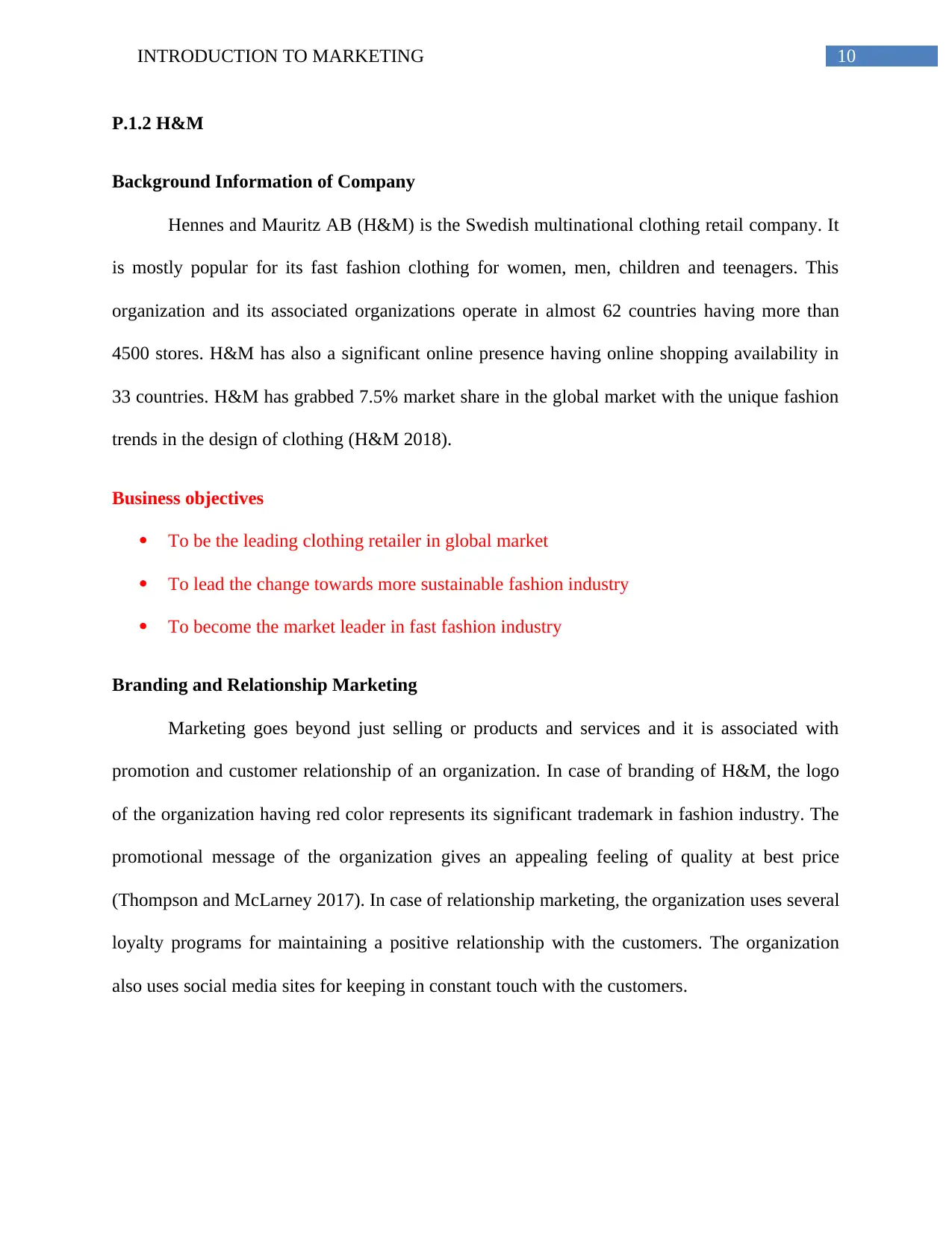
10INTRODUCTION TO MARKETING
P.1.2 H&M
Background Information of Company
Hennes and Mauritz AB (H&M) is the Swedish multinational clothing retail company. It
is mostly popular for its fast fashion clothing for women, men, children and teenagers. This
organization and its associated organizations operate in almost 62 countries having more than
4500 stores. H&M has also a significant online presence having online shopping availability in
33 countries. H&M has grabbed 7.5% market share in the global market with the unique fashion
trends in the design of clothing (H&M 2018).
Business objectives
To be the leading clothing retailer in global market
To lead the change towards more sustainable fashion industry
To become the market leader in fast fashion industry
Branding and Relationship Marketing
Marketing goes beyond just selling or products and services and it is associated with
promotion and customer relationship of an organization. In case of branding of H&M, the logo
of the organization having red color represents its significant trademark in fashion industry. The
promotional message of the organization gives an appealing feeling of quality at best price
(Thompson and McLarney 2017). In case of relationship marketing, the organization uses several
loyalty programs for maintaining a positive relationship with the customers. The organization
also uses social media sites for keeping in constant touch with the customers.
P.1.2 H&M
Background Information of Company
Hennes and Mauritz AB (H&M) is the Swedish multinational clothing retail company. It
is mostly popular for its fast fashion clothing for women, men, children and teenagers. This
organization and its associated organizations operate in almost 62 countries having more than
4500 stores. H&M has also a significant online presence having online shopping availability in
33 countries. H&M has grabbed 7.5% market share in the global market with the unique fashion
trends in the design of clothing (H&M 2018).
Business objectives
To be the leading clothing retailer in global market
To lead the change towards more sustainable fashion industry
To become the market leader in fast fashion industry
Branding and Relationship Marketing
Marketing goes beyond just selling or products and services and it is associated with
promotion and customer relationship of an organization. In case of branding of H&M, the logo
of the organization having red color represents its significant trademark in fashion industry. The
promotional message of the organization gives an appealing feeling of quality at best price
(Thompson and McLarney 2017). In case of relationship marketing, the organization uses several
loyalty programs for maintaining a positive relationship with the customers. The organization
also uses social media sites for keeping in constant touch with the customers.
Paraphrase This Document
Need a fresh take? Get an instant paraphrase of this document with our AI Paraphraser
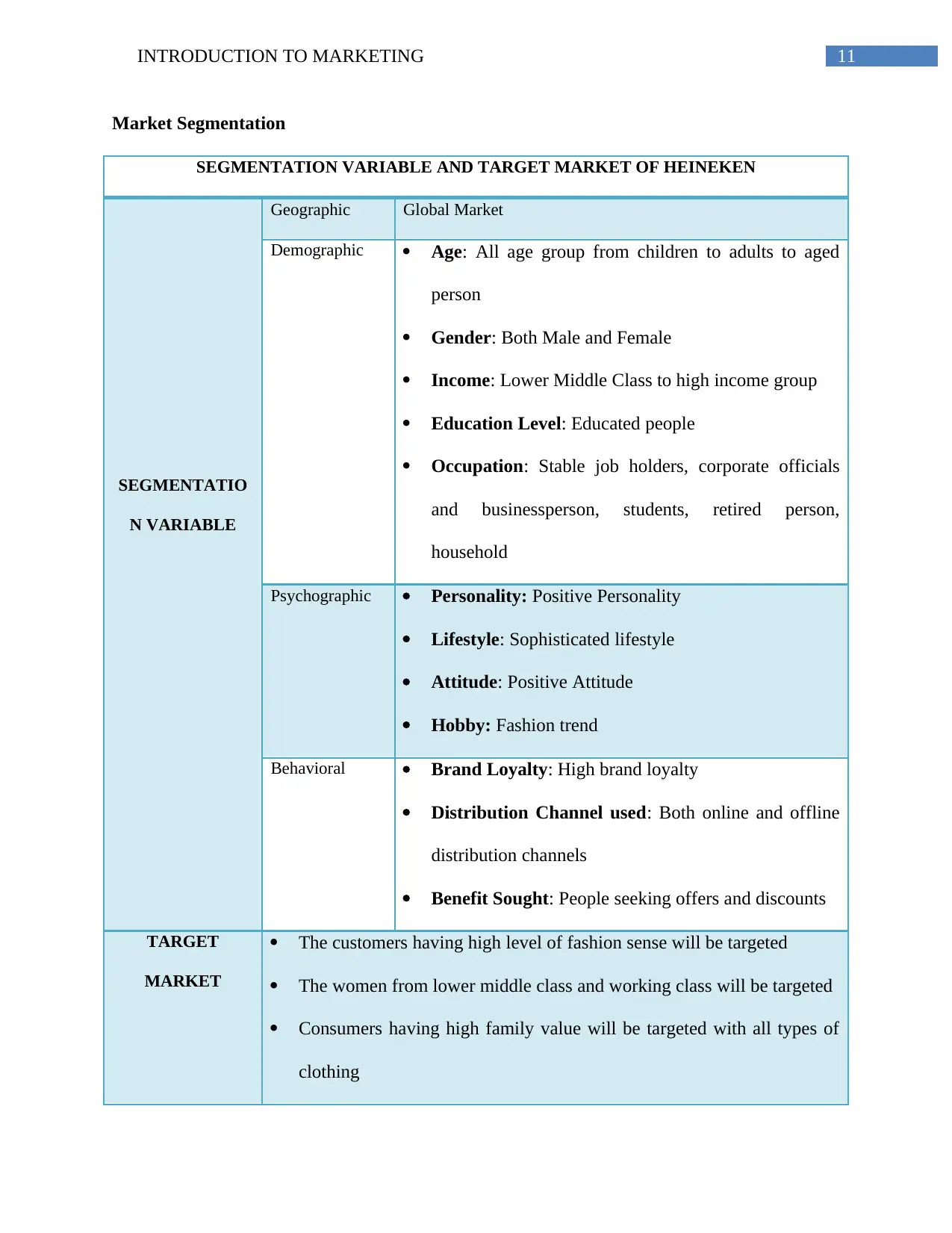
11INTRODUCTION TO MARKETING
Market Segmentation
SEGMENTATION VARIABLE AND TARGET MARKET OF HEINEKEN
SEGMENTATIO
N VARIABLE
Geographic Global Market
Demographic Age: All age group from children to adults to aged
person
Gender: Both Male and Female
Income: Lower Middle Class to high income group
Education Level: Educated people
Occupation: Stable job holders, corporate officials
and businessperson, students, retired person,
household
Psychographic Personality: Positive Personality
Lifestyle: Sophisticated lifestyle
Attitude: Positive Attitude
Hobby: Fashion trend
Behavioral Brand Loyalty: High brand loyalty
Distribution Channel used: Both online and offline
distribution channels
Benefit Sought: People seeking offers and discounts
TARGET
MARKET
The customers having high level of fashion sense will be targeted
The women from lower middle class and working class will be targeted
Consumers having high family value will be targeted with all types of
clothing
Market Segmentation
SEGMENTATION VARIABLE AND TARGET MARKET OF HEINEKEN
SEGMENTATIO
N VARIABLE
Geographic Global Market
Demographic Age: All age group from children to adults to aged
person
Gender: Both Male and Female
Income: Lower Middle Class to high income group
Education Level: Educated people
Occupation: Stable job holders, corporate officials
and businessperson, students, retired person,
household
Psychographic Personality: Positive Personality
Lifestyle: Sophisticated lifestyle
Attitude: Positive Attitude
Hobby: Fashion trend
Behavioral Brand Loyalty: High brand loyalty
Distribution Channel used: Both online and offline
distribution channels
Benefit Sought: People seeking offers and discounts
TARGET
MARKET
The customers having high level of fashion sense will be targeted
The women from lower middle class and working class will be targeted
Consumers having high family value will be targeted with all types of
clothing
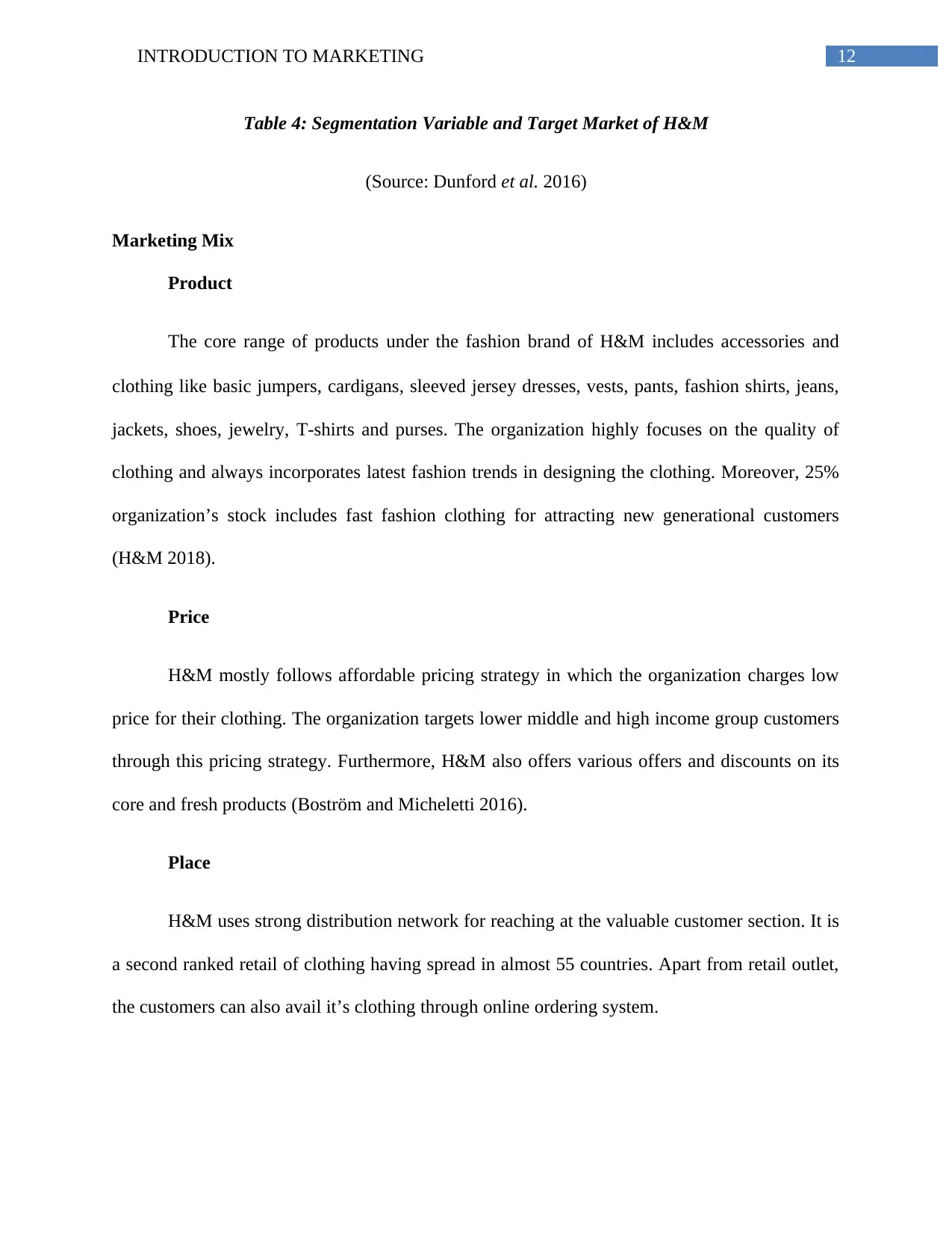
12INTRODUCTION TO MARKETING
Table 4: Segmentation Variable and Target Market of H&M
(Source: Dunford et al. 2016)
Marketing Mix
Product
The core range of products under the fashion brand of H&M includes accessories and
clothing like basic jumpers, cardigans, sleeved jersey dresses, vests, pants, fashion shirts, jeans,
jackets, shoes, jewelry, T-shirts and purses. The organization highly focuses on the quality of
clothing and always incorporates latest fashion trends in designing the clothing. Moreover, 25%
organization’s stock includes fast fashion clothing for attracting new generational customers
(H&M 2018).
Price
H&M mostly follows affordable pricing strategy in which the organization charges low
price for their clothing. The organization targets lower middle and high income group customers
through this pricing strategy. Furthermore, H&M also offers various offers and discounts on its
core and fresh products (Boström and Micheletti 2016).
Place
H&M uses strong distribution network for reaching at the valuable customer section. It is
a second ranked retail of clothing having spread in almost 55 countries. Apart from retail outlet,
the customers can also avail it’s clothing through online ordering system.
Table 4: Segmentation Variable and Target Market of H&M
(Source: Dunford et al. 2016)
Marketing Mix
Product
The core range of products under the fashion brand of H&M includes accessories and
clothing like basic jumpers, cardigans, sleeved jersey dresses, vests, pants, fashion shirts, jeans,
jackets, shoes, jewelry, T-shirts and purses. The organization highly focuses on the quality of
clothing and always incorporates latest fashion trends in designing the clothing. Moreover, 25%
organization’s stock includes fast fashion clothing for attracting new generational customers
(H&M 2018).
Price
H&M mostly follows affordable pricing strategy in which the organization charges low
price for their clothing. The organization targets lower middle and high income group customers
through this pricing strategy. Furthermore, H&M also offers various offers and discounts on its
core and fresh products (Boström and Micheletti 2016).
Place
H&M uses strong distribution network for reaching at the valuable customer section. It is
a second ranked retail of clothing having spread in almost 55 countries. Apart from retail outlet,
the customers can also avail it’s clothing through online ordering system.
⊘ This is a preview!⊘
Do you want full access?
Subscribe today to unlock all pages.

Trusted by 1+ million students worldwide
1 out of 26
Related Documents
Your All-in-One AI-Powered Toolkit for Academic Success.
+13062052269
info@desklib.com
Available 24*7 on WhatsApp / Email
![[object Object]](/_next/static/media/star-bottom.7253800d.svg)
Unlock your academic potential
Copyright © 2020–2025 A2Z Services. All Rights Reserved. Developed and managed by ZUCOL.




